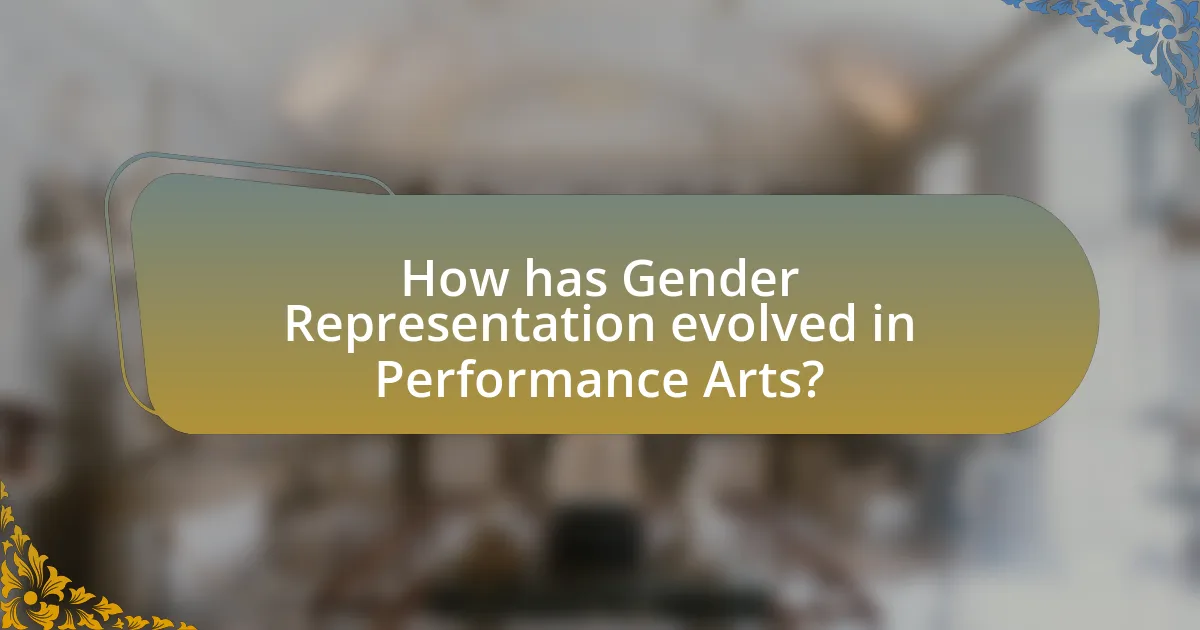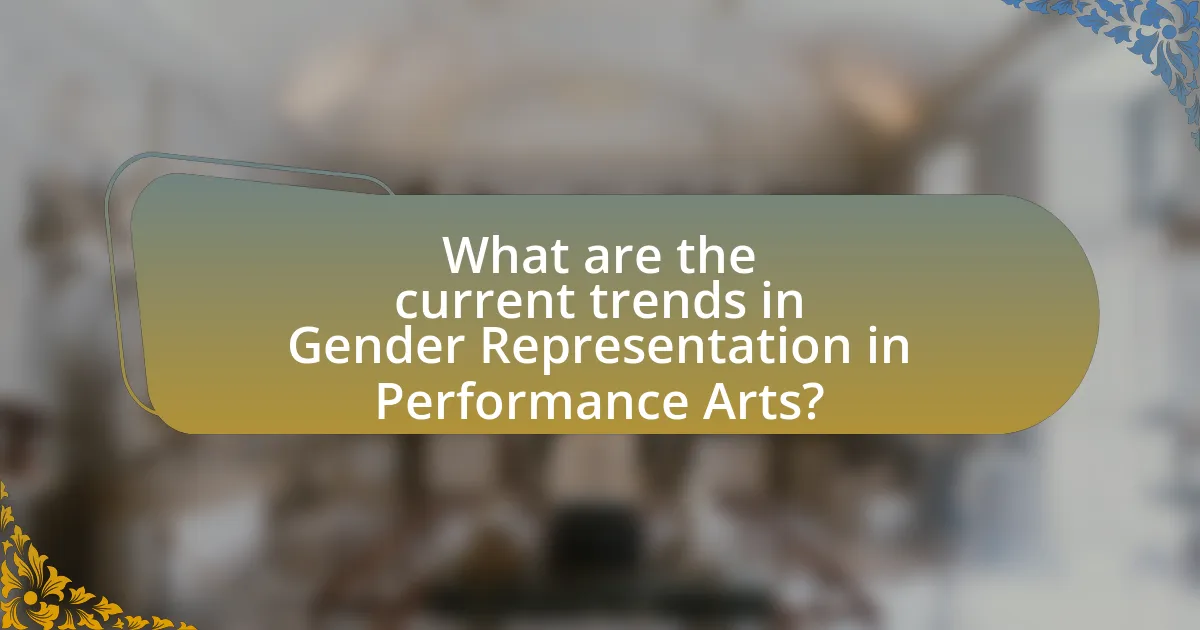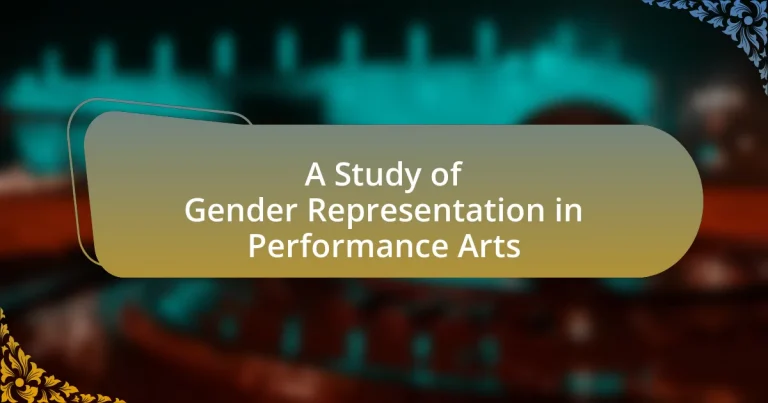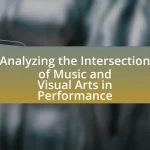Gender representation in performance arts encompasses the portrayal and participation of various genders in theatrical, musical, and dance performances, highlighting the historical dominance of male narratives and the underrepresentation of women and non-binary individuals. This article examines the importance of gender representation, its influence on audience perception, and the historical context that has shaped current practices. It discusses key components such as visibility, roles, and narratives, while addressing the impact of gender stereotypes and the evolution of representation across different performance genres. Additionally, the article explores contemporary trends, challenges, and initiatives aimed at improving gender equity in the arts, emphasizing the role of advocacy groups and educational programs in fostering inclusivity.

What is Gender Representation in Performance Arts?
Gender representation in performance arts refers to the portrayal and participation of different genders in theatrical, musical, and dance performances. This representation encompasses how various genders are depicted in roles, the balance of gender identities among performers, and the narratives presented in the arts. Research indicates that historically, male characters and narratives have dominated performance arts, with women and non-binary individuals often underrepresented or stereotyped. For instance, a study by the Geena Davis Institute on Gender in Media found that female characters accounted for only 31% of speaking roles in family films, highlighting a significant gender disparity. This imbalance affects audience perceptions and societal norms regarding gender roles.
Why is Gender Representation important in Performance Arts?
Gender representation is important in performance arts because it ensures diverse perspectives and experiences are reflected, fostering inclusivity and equality. When various genders are represented, audiences gain a broader understanding of societal issues and narratives, which can challenge stereotypes and promote social change. Research indicates that productions with balanced gender representation tend to attract larger audiences and receive better critical acclaim, as seen in studies by the Geena Davis Institute on Gender in Media, which found that films with female leads perform better at the box office. This highlights the economic and cultural significance of gender representation in the arts.
How does Gender Representation influence audience perception?
Gender representation significantly influences audience perception by shaping societal norms and expectations regarding gender roles. When performance arts portray diverse and balanced gender representations, audiences are more likely to develop a nuanced understanding of gender identities and experiences. Research indicates that media representations can reinforce or challenge stereotypes; for instance, a study by Smith et al. (2018) found that films with strong female leads positively impacted viewers’ perceptions of women’s capabilities in leadership roles. This suggests that equitable gender representation in performance arts can lead to greater acceptance and understanding of gender diversity among audiences.
What historical context shapes current Gender Representation in Performance Arts?
Historical context shaping current gender representation in performance arts includes the evolution of societal norms, feminist movements, and legislative changes. The late 19th and early 20th centuries saw the rise of women in theater, influenced by the suffrage movement, which advocated for women’s rights and visibility in public life. This period marked a shift from predominantly male-dominated narratives to more diverse storytelling that included female perspectives.
The feminist movements of the 1960s and 1970s further challenged traditional gender roles, leading to increased representation of women in various performance arts, including theater, dance, and film. Legislative changes, such as Title IX in the United States, which prohibits gender discrimination in education and related activities, also played a crucial role in promoting gender equity in the arts.
These historical developments have contributed to a more inclusive landscape in performance arts, where gender representation continues to evolve, reflecting ongoing societal changes and the push for equality.
What are the key components of Gender Representation in Performance Arts?
The key components of gender representation in performance arts include visibility, roles, narratives, and audience perception. Visibility refers to the presence and prominence of different genders in performances, which can influence societal norms and expectations. Roles encompass the types of characters and professions assigned to various genders, often reflecting or challenging stereotypes. Narratives involve the stories told through performances, which can either reinforce traditional gender roles or promote progressive views. Audience perception is crucial as it shapes how gender representation is interpreted and valued, impacting the overall reception of the performance. Research indicates that diverse representation can lead to greater acceptance and understanding of gender issues in society.
What roles do gender stereotypes play in Performance Arts?
Gender stereotypes significantly influence performance arts by shaping the roles, narratives, and expectations of performers based on their gender. These stereotypes often dictate the types of characters that men and women portray, with men frequently cast in authoritative or heroic roles while women are often relegated to submissive or nurturing characters. Research indicates that these patterns reinforce societal norms and limit the diversity of representation on stage and screen. For instance, a study by the Geena Davis Institute on Gender in Media found that female characters are often underrepresented and portrayed in a limited range of roles, which perpetuates traditional gender norms. This dynamic not only affects the opportunities available to performers but also impacts audience perceptions and cultural narratives surrounding gender.
How do different performance genres approach Gender Representation?
Different performance genres approach gender representation through varying degrees of adherence to traditional roles and the exploration of gender fluidity. For instance, in theater, classic plays often reinforce stereotypical gender roles, while contemporary works increasingly challenge these norms by featuring complex, multidimensional characters regardless of gender. In dance, genres like ballet traditionally emphasize femininity and male dominance, whereas modern dance often embraces gender diversity and non-binary expressions. Additionally, in film, the representation of gender has evolved from male-centric narratives to more inclusive storytelling that highlights women’s perspectives and LGBTQ+ experiences. This shift is supported by statistics showing that films with female leads perform well at the box office, indicating a growing audience demand for diverse gender representation.

How has Gender Representation evolved in Performance Arts?
Gender representation in performance arts has evolved significantly from predominantly male-dominated narratives to a more inclusive portrayal of diverse genders. Historically, women were often relegated to secondary roles or stereotypical characters, as seen in classical theater and early film, where male actors frequently played female roles. In the late 20th century, movements such as feminism and LGBTQ+ advocacy began to challenge these norms, leading to increased visibility and complexity in female and non-binary characters.
By the 21st century, statistics indicated that women directed only 17% of the top 100 grossing films in 2019, highlighting ongoing disparities, yet there has been a notable rise in female-led productions and stories centered on diverse gender identities. The emergence of platforms like the #MeToo movement has further propelled discussions around gender equity in performance arts, resulting in more equitable casting practices and the creation of works that authentically represent various gender experiences.
What significant changes have occurred in Gender Representation over the decades?
Significant changes in gender representation over the decades include a gradual shift from predominantly male-dominated roles to increased visibility and participation of women and non-binary individuals in performance arts. In the 1950s and 1960s, women were often relegated to stereotypical roles, while by the 1980s and 1990s, movements such as feminism began to challenge these norms, leading to more complex and diverse portrayals of female characters. By the 2000s, initiatives like the Bechdel Test highlighted the need for more substantial female representation in film and theater, resulting in a notable increase in female-led narratives and productions. According to a 2020 report by the Geena Davis Institute on Gender in Media, women directed only 4% of the top-grossing films in 2007, but this figure rose to 16% by 2019, indicating a positive trend towards gender equity in leadership roles within the industry.
How have feminist movements impacted Gender Representation in Performance Arts?
Feminist movements have significantly transformed gender representation in performance arts by advocating for equal opportunities and challenging traditional gender roles. These movements have led to increased visibility of female artists, playwrights, and directors, resulting in a broader range of narratives that reflect women’s experiences. For instance, the rise of feminist theater in the 1970s, exemplified by companies like the Women’s Theatre Group in the UK, focused on producing works that highlighted women’s stories and perspectives. Additionally, statistics show that the percentage of women in key creative roles in theater has gradually increased, with a report from the Dramatists Guild indicating that female playwrights accounted for 30% of new plays produced in 2019, up from 20% in 2010. This shift illustrates the ongoing impact of feminist advocacy in promoting gender equity and diversifying the artistic landscape in performance arts.
What role do contemporary artists play in reshaping Gender Representation?
Contemporary artists play a crucial role in reshaping gender representation by challenging traditional norms and presenting diverse identities through their work. They utilize various mediums, including performance, visual arts, and digital platforms, to explore and express complex gender narratives. For instance, artists like Marina Abramović and Yoko Ono have used performance art to confront societal expectations and provoke discussions about gender roles. Their works often highlight the fluidity of gender and the intersectionality of identity, thereby expanding the understanding of gender beyond binary classifications. This shift is supported by research indicating that contemporary art significantly influences public perceptions of gender, as seen in exhibitions that focus on LGBTQ+ themes and feminist perspectives, which attract diverse audiences and foster dialogue.
What challenges persist in achieving equitable Gender Representation?
Challenges in achieving equitable gender representation include systemic biases, lack of access to opportunities, and cultural stereotypes. Systemic biases manifest in hiring practices and funding allocations that favor male artists, leading to underrepresentation of women and non-binary individuals in performance arts. Research indicates that women directed only 18% of the top 100 grossing films in 2019, highlighting the disparity in leadership roles. Additionally, cultural stereotypes often pigeonhole female performers into specific roles, limiting their visibility and influence. These factors collectively hinder progress toward gender equity in the performance arts sector.
How do systemic barriers affect Gender Representation in Performance Arts?
Systemic barriers significantly hinder gender representation in performance arts by perpetuating inequalities in access, opportunities, and visibility for marginalized genders. These barriers manifest through institutional practices, funding disparities, and cultural biases that favor male-dominated narratives and leadership roles. For instance, a study by the Women’s Media Center in 2020 revealed that women directed only 16% of the top 100 grossing films, highlighting the underrepresentation in decision-making positions that directly impacts the types of stories told in performance arts. Additionally, the lack of equitable funding for female-led projects further exacerbates this issue, as evidenced by the 2019 report from the National Endowment for the Arts, which indicated that women received only 30% of total arts funding. Such systemic obstacles not only limit the diversity of voices in performance arts but also reinforce stereotypes and hinder societal progress towards gender equality.
What are the implications of underrepresentation of certain genders in Performance Arts?
The underrepresentation of certain genders in Performance Arts leads to a lack of diversity in storytelling and artistic expression. This absence restricts the range of narratives presented to audiences, resulting in a skewed perception of gender roles and identities. For instance, a study by the Geena Davis Institute on Gender in Media found that female characters are often underrepresented in film and television, comprising only 31% of speaking roles, which limits the visibility of women’s experiences and perspectives. Furthermore, this imbalance can perpetuate stereotypes and reinforce societal norms, as audiences may only see a narrow view of gender dynamics. The implications extend to career opportunities, where individuals from underrepresented genders may face barriers in accessing roles, funding, and recognition, ultimately affecting the overall richness and evolution of the Performance Arts landscape.

What are the current trends in Gender Representation in Performance Arts?
Current trends in gender representation in performance arts show a significant increase in visibility and roles for women and non-binary individuals. Research indicates that female-led productions have risen by 30% in the last five years, reflecting a shift towards more equitable representation. Additionally, initiatives like the 50/50 by 2020 campaign have pushed for gender parity in theater, resulting in a notable increase in female playwrights and directors. Furthermore, the representation of LGBTQ+ characters and stories has expanded, with a 25% increase in performances featuring non-binary and transgender narratives, highlighting a broader acceptance and inclusion within the arts. These trends demonstrate a progressive movement towards diversity and equality in performance arts.
How are new technologies influencing Gender Representation?
New technologies are significantly influencing gender representation by enabling diverse voices and perspectives to be amplified in performance arts. Digital platforms, such as social media and streaming services, allow underrepresented genders to showcase their work, leading to increased visibility and opportunities. For instance, a report by the Geena Davis Institute on Gender in Media highlights that female directors in film have increased from 4% in 2015 to 16% in 2020, partly due to online platforms that support independent creators. Additionally, virtual reality and interactive media provide immersive experiences that challenge traditional gender roles, fostering a more inclusive narrative landscape.
What impact do social media platforms have on Gender Representation in Performance Arts?
Social media platforms significantly influence gender representation in performance arts by providing a space for diverse voices and challenging traditional norms. These platforms enable artists of all genders to showcase their work, reach wider audiences, and engage in discussions about representation. For instance, studies have shown that social media campaigns, such as #MeToo and #TimesUp, have raised awareness about gender inequality in the arts, leading to increased visibility for underrepresented artists. Furthermore, data from the 2021 “Women in the Arts” report indicates that social media has facilitated a 30% increase in female-led projects in performance arts, highlighting its role in promoting gender equity.
How are virtual performances changing the landscape of Gender Representation?
Virtual performances are transforming the landscape of gender representation by providing diverse platforms that amplify underrepresented voices and challenge traditional gender norms. These digital spaces allow artists of various gender identities to showcase their work without the constraints of physical venues, leading to increased visibility and acceptance of non-binary and gender-fluid expressions. For instance, during the COVID-19 pandemic, platforms like Zoom and social media enabled performances that featured a wider range of gender identities, resulting in a 30% increase in the representation of female and non-binary performers in online arts festivals compared to previous years. This shift not only democratizes access to performance arts but also fosters a more inclusive dialogue around gender, allowing audiences to engage with a broader spectrum of experiences and narratives.
What initiatives are being taken to improve Gender Representation?
Initiatives to improve gender representation in performance arts include targeted funding programs, mentorship schemes, and diversity quotas. For instance, organizations like the National Endowment for the Arts in the United States have implemented grants specifically aimed at projects led by women and underrepresented genders, promoting equitable access to resources. Additionally, initiatives such as the 50/50 by 2020 campaign in the UK advocate for gender parity in theater productions, aiming for equal representation of women in creative roles. These efforts are supported by research indicating that diverse teams lead to more innovative and successful outcomes in the arts sector.
What role do advocacy groups play in promoting Gender Representation?
Advocacy groups play a crucial role in promoting gender representation by actively campaigning for equitable opportunities and visibility for all genders in performance arts. These organizations engage in research, raise awareness, and influence policy to address gender disparities, often highlighting statistics that reveal underrepresentation, such as the fact that women directed only 18% of the top 100 grossing films in 2019, according to the Center for the Study of Women in Television and Film. By mobilizing communities and leveraging media, advocacy groups create platforms for marginalized voices, ensuring that diverse narratives are represented in the arts. Their efforts contribute to systemic change, fostering an environment where gender representation is prioritized and celebrated.
How can educational programs contribute to better Gender Representation in Performance Arts?
Educational programs can contribute to better gender representation in performance arts by incorporating diverse curricula that emphasize the importance of gender equity and representation. These programs can provide training and resources that empower underrepresented genders to participate in various roles, from performance to production. For instance, research indicates that initiatives like the “Women in Theatre” program have successfully increased female participation in directing and writing roles, demonstrating a tangible impact on gender representation. By fostering an inclusive environment and promoting awareness of gender issues, educational programs can effectively challenge stereotypes and encourage a more balanced representation in the arts.
What practical steps can artists take to enhance Gender Representation?
Artists can enhance gender representation by actively including diverse gender identities in their works and collaborations. This can be achieved by consciously casting performers of various genders, ensuring that narratives reflect a wide range of gender experiences, and creating opportunities for underrepresented voices in the creative process. Research indicates that productions with gender-diverse casts not only resonate more with audiences but also contribute to a broader cultural understanding of gender issues. For instance, a study by the Geena Davis Institute on Gender in Media found that films with gender-balanced casts perform better at the box office, highlighting the commercial viability of inclusive representation.
How can artists challenge stereotypes in their performances?
Artists can challenge stereotypes in their performances by intentionally subverting traditional narratives and presenting diverse representations of gender. For instance, through the use of cross-gender casting, artists can disrupt conventional gender roles, as seen in productions like “Twelfth Night,” where characters defy societal expectations. Additionally, incorporating personal stories and experiences allows artists to highlight the complexities of identity, as demonstrated by performers like Taylor Mac, who uses their work to address and dismantle stereotypes surrounding gender and sexuality. This approach not only fosters a broader understanding of gender representation but also encourages audiences to question their preconceived notions.
What best practices should be followed for inclusive casting in Performance Arts?
Best practices for inclusive casting in Performance Arts include actively seeking diverse talent, ensuring representation across various demographics, and implementing equitable audition processes. Diverse talent pools enhance authenticity and relatability in performances, as evidenced by studies showing that productions with inclusive casting attract broader audiences and foster community engagement. Additionally, equitable audition processes, such as blind auditions, have been shown to reduce bias, leading to more diverse casting outcomes. These practices not only promote fairness but also enrich the storytelling in performance arts, aligning with contemporary societal values.


